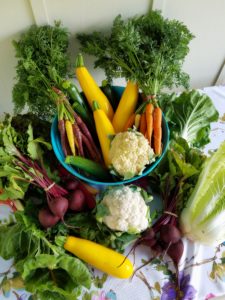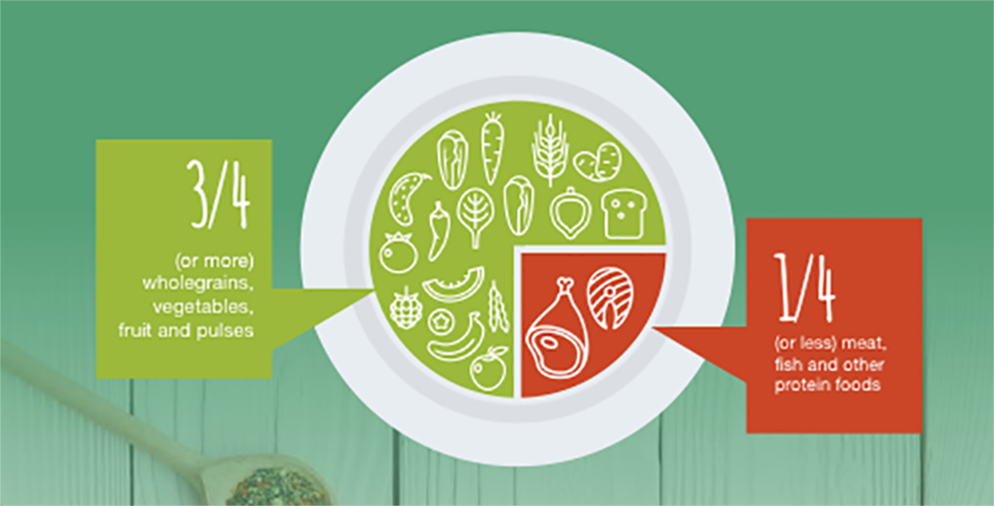Eat a diet rich in wholegrains, vegetables, fruit and beans
PERSONAL RECOMMENDATIONS
- Consume a diet that provides at least 30 grams per day of fibre from food sources.
- Eat a diet high in all types of plant foods including at least five portions or servings (at least 400g or 15oz in total) of a variety of non-starchy vegetables and fruit every day.
- Include in most meals foods containing wholegrains, non-starchy vegetables, fruit and pulses (legumes) such as beans and lentils.
There is strong scientific evidence that eating wholegrains protects against colorectal cancer, and that eating foods containing dietary fibre protects against colorectal cancer and against weight gain, overweight and obesity. Most diets that are protective against cancer are rich in foods of plant origin.
WHAT IS A PLANT FOOD?
Plant foods are foods that are derived from plants and are naturally high in nutrients, high in dietary fibre but low in energy density. Our diets should be based primarily on plant foods, particularly unprocessed cereals and grains, non-starchy vegetables and fruit, legumes and pulses (peas, beans and lentils), with a limited amount of food derived from animals e.g. meat products, dairy products. Examples of plant foods include fruit, vegetables, whole grains and legumes. One portion of non-starchy vegetables or fruit is approximately 80 grams or 3 ounces.
UNPROCESSED CEREALS AND GRAINS
Cereals (grains) are the seeds of cultivated grasses e.g. wheat, rice, maize (corn), millet, barley, oats, and rye. The majority of the cereals and grains that we eat are processed or refined. During manufacturing, the grains are broken up into pieces and different parts of the grain are sifted out to produce a grain that is easier to chew, faster to cook and lighter in colour e.g. white rice, white flour. A lot of the fibre, protein and B vitamins in the original grain are lost through this processing or refining. Grains commonly go through additional processing before they reach the supermarket shelf e.g. the addition of sugar to cereals during the production of processed breakfast cereals. On the other hand, wholegrain products go through limited processing and generally the grain is kept intact. In this way unprocessed grains (wholegrains) are a much better source of nutrition, providing more dietary fibre, resistant starch, antioxidants and vitamins and minerals. Examples of unprocessed cereals and grains include brown rice, oats, brown pasta, wholegrain or brown bread, couscous, quinoa and unsweetened breakfast cereals.
NON-STARCHY VEGETABLES

Vegetables can be categorised into two main groups; non-starchy and starchy vegetables. Starchy vegetables include potatoes, yam, sweet potatoes, and plantain. Although they are classified as vegetables by some, they are high in carbohydrate and therefore they do not count towards your fruit and vegetable intake. Instead they are counted as a carbohydrate source i.e. an alternative to pasta, rice or bread in the diet.
Non-starchy vegetables count towards your fruit and vegetable intake and are a rich source of vitamins, minerals and fibre. Non-starchy vegetables can be further divided into different families including green, leafy vegetables (e.g. spinach, lettuce, kale); root vegetables (carrots, butternut squash, beets, parsnips, turnips, swede) cruciferous vegetables (the cabbage family, e.g. cabbage, brussels sprouts, broccoli, cauliflower) and allium vegetables (e.g. onions, garlic, and leeks).
LEGUMES AND PULSES
Legumes are a family of plant foods which include fresh peas, fresh beans, soybeans, peanuts and pulses. Pulses refer to the dried seed of the legume family, and include foods such as dried peas, chickpea, beans and lentils. Legumes have an important role in the cancer prevention diet as they are plant foods that are both high in protein and a rich source of fibre, therefore providing a nutritious alternative to meat.
HOW DO PLANTS ALTER CANCER RISK?
Plant foods reduce cancer risk in three main ways.
The strongest evidence linking plant foods and cancer, is for fibre-containing foods (e.g. fruit, vegetables, wholegrain bread, wholegrain rice, brown pasta, oats) and bowel cancer. Fibre has many different benefits, one of the main ones being helping to maintain regular bowel movements. Fibre helps to speed up the passage of food through our gut, something which is thought to be beneficial for cancer prevention, particularly for cancers of the bowel. A review of all the studies looking at fibre and bowel cancer found that for every 10g of fibre eaten every day, there is a 10% lower risk of developing bowel cancer. Getting fibre by eating legumes showed the best risk reduction (e.g. peas, beans, chickpeas, lentils) (38% reduced risk of cancer), followed by eating wholegrain cereals, fruit and vegetables (WCRF/AICR Systematic Literature Review Continuous Update Project Report, Colorectal Cancer 2010).
Individual groups of fruits and vegetables have also been shown to reduce the risk of specific cancers. There is strong evidence to show that eating non-starchy vegetables protect against cancers of the mouth and throat. There is strong evidence to prove that garlic is protective against cancers of the bowel. Higher fruit consumption is protective against cancers of the mouth, throat and lung. Fruit and vegetables are rich sources of vitamins and minerals, which help to keep our immune system and our body healthy; they are also good sources of phytochemicals and antioxidants. These compounds are very active and can help to protect our bodies from damage to cells which can lead to cancer.
Finally, plant foods are generally low in energy/calories (with a few exceptions) and eating a large amount of plant food helps to control the number of calories we consume. Therefore consuming plant foods helps us to achieve the first cancer prevention recommendation of maintaining a healthy body weight and preventing overweight/obesity, something which we know is associated with an increased risk of 12 different cancers.
WHICH ‘PLANT FOODS’ SHOULD I BE EATING AND HOW MUCH?
Plant food should make up the majority of our diet, with a limited amount of animal foods. The WCRF recommends eating at least 400g (14oz) of fruit and non-starchy vegetables a day, which equates to a minimum of 5 portions or ‘5-a-day’. Fresh, frozen, dried and canned in water or natural juices all count towards your ‘5 a day’. Limit fruit juice to unsweetened varieties and only one glass a day. Limit dried fruit to 1 tablespoon a day (30g). Pulses e.g. lentils, peas and beans, also count towards 1 portion of your ‘5-a-day’ and are also a great source of fibre and protein.
Different types of fruit and vegetables contain different vitamins, minerals and phytochemicals and that is why including a variety of these foods is so important. A good rule of thumb is to include a range of different coloured fruit and vegetables in your daily diet. This will help to ensure you are eating a range of different vitamins and minerals.
One portion of fruit and vegetables is roughly 80g weighed (2 1/2 – 3 oz). Examples of 1 serving are listed below:
- 3 heaped tablespoons cooked vegetables e.g. carrots, parsnips, broccoli
- 1 cereal bowl of salad leaves e.g. lettuce, rocket
- 1 slice of a large fruit e.g. melon
- 1 medium whole fruit e.g. apple, banana, orange
- 2 small whole fruits e.g. plums, kiwis, mandarin orange
- 1-2 handfuls berries e.g. strawberries, raspberries, blueberries
- 3-4 heaped tablespoons of cooked or canned pulses e.g. beans, peas or lentils
- 1 tablespoon of dried pulses e.g. dried lentils, dried chickpeas
Starchy vegetables (e.g. potatoes, sweet potatoes, yam), grains (e.g. rice, quinoa or oats) and anything fruit flavoured (or containing added sugar or salt) (e.g. fruit jams, olives) do not count towards your 5-a-day.
Aside from fruit, vegetables and pulses, our plate should contain healthy grains and cereals e.g. rice, oats, pasta, bread, couscous and unsweetened breakfast cereal. We should always choose wholegrain or brown varieties over ‘white’. It is important to limit processed grains and cereals as these can be high in fat, sugar and salt.
As a rule of thumb, at mealtimes a minimum of ¾ of our plate should be made up of wholegrains, fruit, vegetables and pulses. The remaining ¼ (or less) should contain lean meats, fish or other protein foods. See the photo below as an example of how your plate should look at mealtimes. Meat has traditionally been the centre of Irish meals; however we need to rethink the way we plan our meals and start centring our dishes on plant foods rather than animal foods. This change will greatly help to reduce our risk of many different cancers and will reduce overweight/obesity.










 Contact
Contact